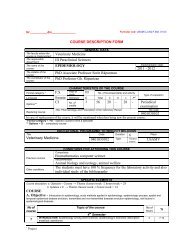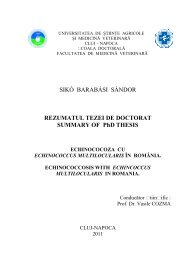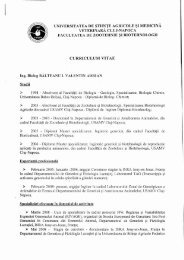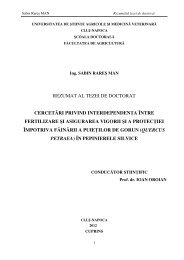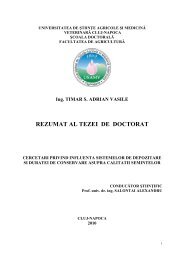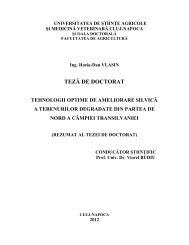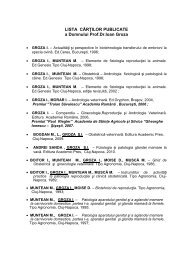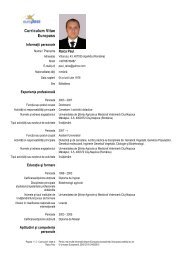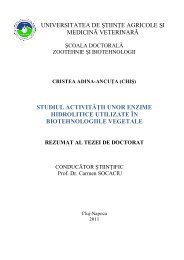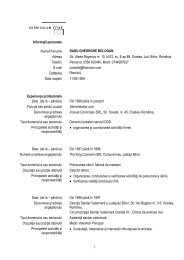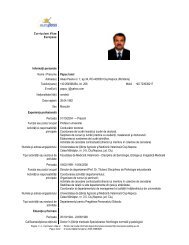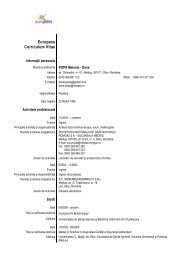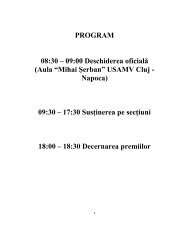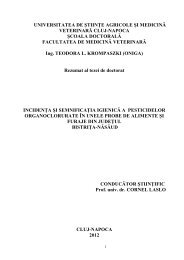Marioara Urda _Grebenisan_ rezumat_teza_engleza - USAMV Cluj ...
Marioara Urda _Grebenisan_ rezumat_teza_engleza - USAMV Cluj ...
Marioara Urda _Grebenisan_ rezumat_teza_engleza - USAMV Cluj ...
Create successful ePaper yourself
Turn your PDF publications into a flip-book with our unique Google optimized e-Paper software.
UNIVERSITY OF AGRICULTURAL SCIENCES AND<br />
VETERINARY MEDICINE CLUJ-NAPOCA<br />
THE DOCTORAL SCOOL<br />
FACULTY OF AGRICULTURE<br />
Biol. <strong>Marioara</strong> URDA (căs. GREBENIŞAN)<br />
Summary of the PhD thesis<br />
Research on the structure of di- and tetraploid red<br />
clover seed plants and the influence of meiotic<br />
anomalies on the fertility of autotetraploid forms<br />
Scientific coordinator:<br />
Prof. univ. dr. MIRCEA SAVATTI<br />
CLUJ-NAPOCA<br />
2011
<strong>Marioara</strong> GREBENIŞAN Summary of the PhD thesis<br />
Research on the structure of di- and tetraploid red clover seed plants and the influence of meiotic<br />
anomalies on the fertility of autotetraploid forms<br />
THESIS CONTENT<br />
Foreword ……………………………………………………………………….<br />
CHAPTER I<br />
1. Autopolyploidy-genetic phenomenon and comparative aspects with<br />
diploid red clover ……………………………………………………….<br />
1.1. General view ………………………………………………………...<br />
1.2. Selection for the seed number per flower head ……………………...<br />
1.3. The importance of red clover culture and main objectives studied ….<br />
1.3.1 Production capacity …………………………………………….<br />
1.3.2. Chemical composition …………………………………………<br />
1.3.3. Nutritional value ……………………………………………….<br />
1.3.4. Agrotechnical importance ……………………………………...<br />
1.3.5. Honey plants …………………………………………………...<br />
1.3.6. Ecological plasticity ……………………………………………<br />
1.4. Induction of polyploidy in red clover ………………………………..<br />
1.4.1. Methods used in inducing polyploidy<br />
1.5. Comparative aspects between diploid and tetraploid forms of<br />
red clover …………………………………………………………….<br />
1.5.1. Plant morphology ………………………………………………<br />
1.5.2. Anatomical characters of stem …………………………………<br />
1.5.3. Characteristics of sexual elements ……………………………..<br />
1.5.4. Physiological characters ……………………………………….<br />
1.5.5. Quantitative and qualitative aspects of production …………….<br />
1.6. Causes of low fertility in red clover with different levelsof ploidy …<br />
1.6.1. Morphological causes ………………………………………….<br />
1.6.1.1. Changing productivity elements for seed yield ………...<br />
1.6.2. Modification of morphological characters that affect pollinating<br />
insects flight ……………………………………………………...<br />
1.6.3. Red clover pollinating species and ways to improve their work …….<br />
1.6.4. Cytological causes ……………………………………………..<br />
1.6.4.1. Meiosis abnormalities ………………………………….<br />
1.6.4.2. Meiosis in autotetraploid red clover …………………...<br />
1.6.4.3. Aneuploidy ……………………………………………...<br />
1.6.5. Embryological causes ………………………………………….<br />
1.6.6. Genetic causes ………………………………………………….<br />
1.6.7. Parasterility …………………………………………………….<br />
1.6.8.Independent causes of the genetic basis ………………………..<br />
C H A P T E R I I<br />
2. Pedoclimatic conditions in which experiments were conducted ………<br />
2.1. Experiment location ……………………………………………...<br />
2.2. Agro-physical, hydro-physical, agrochemical and agro-biological<br />
traits of soil ……………………………………………………...<br />
2<br />
11<br />
13<br />
13<br />
18<br />
21<br />
21<br />
22<br />
22<br />
22<br />
23<br />
23<br />
23<br />
23<br />
27<br />
27<br />
28<br />
28<br />
29<br />
31<br />
32<br />
33<br />
33<br />
35<br />
37<br />
40<br />
40<br />
40<br />
42<br />
44<br />
47<br />
50<br />
54<br />
58<br />
58<br />
60
<strong>Marioara</strong> GREBENIŞAN Summary of the PhD thesis<br />
Research on the structure of di- and tetraploid red clover seed plants and the influence of meiotic<br />
anomalies on the fertility of autotetraploid forms<br />
2.3. Climatic conditions in which experiments were conducted ……..<br />
2.3.1. Thermal regime ………………………………………….<br />
2.3.2. Rainfall …………………………………………………...<br />
2.3.3. Other weather conditions …………………………………<br />
C H A P T E R I I I<br />
3. Research on the structure of red clover seed plants and the effect on<br />
seed yield ……………………………………………………………..<br />
3.1. Introduction ………………………………………………………<br />
3.2. Materials and methods …………………………………………...<br />
3.3. Results and discussion …………………………………………...<br />
3.3.1. Components of red clover seed yield …………………….<br />
3.3.1.1. Number of flower heads/plant and per s. m ………<br />
3.3.2. The number of flowers/flower head ……………………...<br />
3.3.3. The number of seeds per flower head …………………….<br />
3.3.4. The average percentage of seeds formation ………………<br />
3.3.5. Thousand kernel weight (TKW) ………………………….<br />
3.3.6. The calculated and real seed yield ………………………..<br />
3.3.6.1. Flowering stages and seed yield ………………….<br />
C A P I T O L U L I V<br />
4. Pollination and seed formation process in diploid and tetraploid red clover<br />
(Trifolium pratense L.) for Transylvania conditions ………………………<br />
4.1. Red clover pollination particularities in relation with the number and type<br />
of pollinators ………………………………………………………….<br />
4.1.1. Introduction ………………………………………………<br />
4.1.1.1. Research method …………………………………<br />
4.2. Result and disscutions …………………………………………<br />
4.2.1. Abiotic and biotic factors involved in red clover<br />
pollination ………………………………………………...<br />
4.2.2. Flowering period …………………………………………<br />
4.2.3. Pollinators distribution in seed crops …………………….<br />
4.2.4. Total number of bees and bumble bees …………………..<br />
4.2.5. Daily frequency of bees and bumble bees ………………..<br />
4.2.6. Bees and bumble bees waiting time on red clover flower<br />
heads ………………………………………………………....<br />
4.2.7. Comparative aspects regarding the total number of<br />
“insect-units” and the relative fertility of red clover …….<br />
4.3. Aspects of correlation between weather conditions and pollinators<br />
flight …………………………………………………………….<br />
CHAPTER V<br />
5. The comparative effects of the micro- and macrosporogenesis of the red<br />
clover with different levels of ploidy, in relation with its fertility ………<br />
5.1. The evolution of embryogenesis and its influence on fertility ….<br />
3<br />
68<br />
70<br />
72<br />
75<br />
76<br />
76<br />
81<br />
84<br />
84<br />
85<br />
89<br />
94<br />
96<br />
98<br />
100<br />
105<br />
113<br />
113<br />
113<br />
115<br />
116<br />
116<br />
122<br />
125<br />
127<br />
129<br />
132<br />
133<br />
135<br />
139<br />
139
<strong>Marioara</strong> GREBENIŞAN Summary of the PhD thesis<br />
Research on the structure of di- and tetraploid red clover seed plants and the influence of meiotic<br />
anomalies on the fertility of autotetraploid forms<br />
5.1.1. General view ……………………………………………...<br />
5.2. Material and method …………………………………………...<br />
5.3. Results and discussions ………………………………………...<br />
5.3.1. Testing pollen quality …………………………………….<br />
5.3.2. Testing germination, elongation and the indicator of<br />
in vitro pollen viability …………………………………...<br />
5.3.3. The growth of in vitro pollen tubes ………………………<br />
5.3.4. The growth of in vitro pollen tubes in detached pistils …..<br />
5.4. Embryogenesis in di- and tetraploid red clover ………………..<br />
5.4.1. General view ……………………………………………...<br />
5.5. Material and method …………………………………………...<br />
5.6. Results and discussions ………………………………………...<br />
5.6.1. Phases of embryogenesis …………………………………<br />
5.6.2. Comparative aspects regarding the fertility of di- and<br />
tetraploids ………………………………………………..<br />
CHAPTER VI<br />
6. The influence of meiotic anomalies on the fertility of autotetraploid<br />
forms of red clover …………………………………………………….<br />
6.1. Introduction …………………………………………………….<br />
6.2. Material and method …………………………………………...<br />
6.3. Meiosis and its consequences upon fertility …………………...<br />
6.3.1. Meiosis in the case of eutetraploids ………………………….<br />
6.3.2. The relationship between meiosis and fertility …………...<br />
6.4. Meiosis in the case of tetraploids ……………………………...<br />
6.5. Meiosis in the case of aneuploids ……………………………...<br />
6.5.1. The relationship between meiosis and fertility …………..<br />
CHAPTER VII<br />
7. The influence of haploid and diploid pollen in the fertilization process<br />
in red clover (Trifolium pratense L.) …………………………………<br />
7.1. General view …………………………………………………...<br />
7.2. Material and method …………………………………………...<br />
7.3. Results and discussions ………………………………………...<br />
7.3.1. The number of flowers per flower head ………………….<br />
7.3.2. The average number of seeds per flower head …………...<br />
7.3.3. The influence of the number of diploid pollen grains in<br />
diploid red clover flower heads (unisolated plots) ……...<br />
7.3.4. The influence of the haploid pollen on the average<br />
number of seeds per flower head in tetraploid red clover<br />
(unisolated plots) ………………………………………..<br />
7.3.5. The influence of the diploid pollen on the average number<br />
of seeds per flower head in diploid red clover (plots<br />
isolated with sainfoin) …………………………………...<br />
7.3.6. The influence of the haploid pollen on the average<br />
4<br />
139<br />
141<br />
143<br />
143<br />
144<br />
147<br />
147<br />
150<br />
150<br />
152<br />
154<br />
154<br />
164<br />
172<br />
172<br />
173<br />
175<br />
176<br />
179<br />
183<br />
184<br />
186<br />
188<br />
188<br />
189<br />
191<br />
191<br />
194<br />
194<br />
196<br />
197
<strong>Marioara</strong> GREBENIŞAN Summary of the PhD thesis<br />
Research on the structure of di- and tetraploid red clover seed plants and the influence of meiotic<br />
anomalies on the fertility of autotetraploid forms<br />
number of seeds per flower head in tetraploid red clover<br />
( plots isolated with sainfoin) ……………………………<br />
7.3.7. The average percentage of seed formation ………………<br />
7.3.8. The influence of the diploid pollen on the average<br />
percentage of formed seeds in diploid red clover<br />
(unisolated plots and plots isolated with sainfoin) ……...<br />
7.3.9. The influence of the haploid pollen on the average<br />
percentage of formed seeds in tetraploid red clover<br />
(unisolated plots and plots isolated with sainfoin) ……...<br />
CONCLUSIONS.................................................................................................<br />
BIBLIOGRAPHY...............................................................................................<br />
SUMMARY IN ROMANIAN<br />
SUMMARY IN ENGLISH<br />
5<br />
198<br />
199<br />
199<br />
201<br />
205<br />
211
<strong>Marioara</strong> GREBENIŞAN Summary of the PhD thesis<br />
Research on the structure of di- and tetraploid red clover seed plants and the influence of meiotic<br />
anomalies on the fertility of autotetraploid forms<br />
The economic importance of red clover favoured the development of<br />
research in the direction of deeper knowledge of its biological characteristics, with<br />
special focus on those related to genotype fertility, in order to counteract the<br />
oscillating tendency of the seed yields and to elaborate methodologies able to<br />
ensure high seed yields.<br />
The research development in this area increased mainly after 1940, when the<br />
Swedish scientist LEVAN created the first tetraploid clover. The autotetraploid red<br />
clover is important for breeding and production, as it is capable to provide 30-40%<br />
more forage mass than the diploid forms, as well as better resistance to biotic and<br />
abiotic stress.<br />
In spite of all its advantages, the extensive spreading of red clover in cultures<br />
is quite limited, due to its relatively low fertility, as compared to the diploid<br />
genotype.<br />
This fact generated a lot of biological, genetic and agricultural investigations,<br />
leading to the conclusion that the negative biological feature is determined by<br />
morpho-physiological factors but mainly by the genetic ones.<br />
The subject was dealt with from the point of view of the aspects which have<br />
a negative influence on the fertility of the red clover with different ploidy levels.<br />
Here are some of the aspects that were taken into consideration:<br />
- the direct decrease in fertility of the autotetraploid red clover as a result of<br />
the morphological modifications that plants go through because of<br />
polyploidization;<br />
- the influence of the pollination process and the effectiveness of the<br />
entomophile pollination correlated with abiotic factors upon fertility;<br />
- the cytologic causes that could have a negative impact upon red clover<br />
genotypes, such as factors in the category of meiotic anomalies at tetraploid<br />
and aneuploid levels;<br />
- causes of embryological nature conditioned by the quality of pollen,<br />
fertilization and endosperm formation, development and abortion etc.<br />
6
<strong>Marioara</strong> GREBENIŞAN Summary of the PhD thesis<br />
Research on the structure of di- and tetraploid red clover seed plants and the influence of meiotic<br />
anomalies on the fertility of autotetraploid forms<br />
- the influence of environmental conditions on the seed production process<br />
- independent causes of genetic nature, facilitated by the disturbing effect of<br />
haploid pollen on the process of tetraploid genotypes fertilization<br />
The present thesis has tried to elucidate the phenomenon by correlating our own<br />
data with the various suggestions offered by scientific literature.<br />
Most research has pointed out the fact that partial sterility of tetraploid red<br />
clover is not a simple phenomenon, but the result of cytologic, genetic and<br />
physiological imbalance in which a large number of genes are involved. As a<br />
consequence, genetic variability may be used by selection, with a view to increasing<br />
the fructification percentage, which will then generate better fertility by reducing<br />
the frequency of irregularities in the fructification process, irrespective of any<br />
causal phenomena and the stage they occur at.<br />
In order to cover a larger area when analysing red clover fertility and ploidy<br />
factors, we used two base fields, situated in <strong>Cluj</strong>-Napoca and Jucu (24 km from<br />
<strong>Cluj</strong>-Napoca), as well as other locations, the Cojocna Farm belonging to UASVM-<br />
<strong>Cluj</strong>-Napoca and cultures belonging to private farmers within the area between<br />
<strong>Cluj</strong>-Viseul de Jos and from Viseul de Jos.<br />
In spite of the well-known inconstant seed yield in red clover, we usually<br />
consider it enough to determine it empirically, without analysing the causal<br />
relations, the importance of the individual components of the seed yield or the<br />
possibilities to influence them.<br />
The red clover seed yield is the result of cumulated action of four main<br />
components: the number of flower heads/plant, the number of flowers to turn to<br />
fruit/ flower head, the seed weight/plant and the weight-of-thousand-kernels. There<br />
are differences between these components in what regards their contribution to the<br />
total seed quantity, the genetic variation and the potential selection response.<br />
It was noticed there is a relationship between the structure of the red clover<br />
seed plants and their capacity to produce a certain seed quantity per surface unit.<br />
7
<strong>Marioara</strong> GREBENIŞAN Summary of the PhD thesis<br />
Research on the structure of di- and tetraploid red clover seed plants and the influence of meiotic<br />
anomalies on the fertility of autotetraploid forms<br />
The determination of blooming flower heads has revealed a wide range of<br />
oscillation according to genotype, as the diploid forms are superior to the tetraploid<br />
ones, and also in relation with the ecological culture area (table 3.1).<br />
As regards the intrinsic aspects of seed production, it has been proved that<br />
there are significant differences between the number of flower heads/individual<br />
plant and the number of flower heads/surface unit (table 3.2). The diploid forms<br />
appear to be superior to the tetraploid ones, if we consider the number of flower<br />
heads/sq m, which has a negative impact upon the yield of the tetraploid seed<br />
plants.<br />
The number of flowers/flower head is a determinant element for plant<br />
sexuality in clover, being considered a quite precise indicator of potential fertility.<br />
The highest values occur at maximum flowering time; generally speaking, diploid<br />
forms provide a higher number of flowers per flower head, as compared to<br />
tetraploid genotypes (table 3.3).<br />
Another observation is that, by delaying the first cut, there occurs a<br />
decreasing tendency in what regards the number of seeds/flower head, in direct<br />
correlation with the ecological culture area (table 3.5).<br />
The weight-of-thousand-kernels indicator displays the most reduced<br />
oscillation. Apparently there is a certain influence of the first cut timing upon this<br />
trait. The differences that occur are in favour of the tetraploid genotypes (1.6-1.7 g<br />
for 2n and 2.2-2.4g for 4n) and are not an advantage in the process of initiating<br />
tetraploid red clover cultures.<br />
As far as the determination of the production capacity of the seed plants is<br />
concerned, the calculations of the biological yield based on average values of the<br />
individual production factors outline significant differences between the calculated<br />
yield and the real yield, the one obtained in the field. These differences are<br />
conditioned by the ecological culture area, climatic conditions and genetic<br />
differences of the biological material. Major influence comes from the lack of<br />
uniformity in what regards the flowering and seed ripening, precarious pollination,<br />
8
<strong>Marioara</strong> GREBENIŞAN Summary of the PhD thesis<br />
Research on the structure of di- and tetraploid red clover seed plants and the influence of meiotic<br />
anomalies on the fertility of autotetraploid forms<br />
field work, harvesting periods, as well as the inherent loss occurring in the field, all<br />
these leading to the already mentioned differences (table 3.11).<br />
One of the key-ways that can lead to the reducing of the seed yield loss lies<br />
in directing the seed plant flowering process, which has to last for a short time, with<br />
a flowering climax, thus ensuring the uniform ripening of the seed plants.<br />
It was noticed that the poliploidization process of the red clover produces<br />
certain morphological modifications in the plant, which cause a diminishing of the<br />
productive capacity of the seed plants of the 4n type rather that of those of the 2n<br />
type.<br />
These modifications are enhanced by soil conditions and climatic factors,<br />
which can influence, in a positive or negative way, upon the productivity<br />
differences of the two forms of red clover with different ploidy levels.<br />
The existence of genetic variability that can be used, for certain categories of<br />
seed production, with tetraploid genotypes of red clover draws us to the conclusion<br />
that the fructification potential of tetraploid red clover can be improved by<br />
selection. However, the full exploitation of this potential requires substantial<br />
improvement of the pollination conditions.<br />
The determinations referring to the pollinating entomofauna and the<br />
pollination frequency show the fact that the main pollinators of the red clover are<br />
honey bees and bumble bees species (table 4.3).<br />
There is also an interrelation between the biotic and abiotic factors and the<br />
efficiency of the pollination done by apoides in the case of red clover seed plants.<br />
An analysis of the total number of bees and bumble bees that visit the red<br />
clover fields highlights the fact that, as compared to the total number of apoides,<br />
only 49.2-88.6% visits the tetraploid red clover, which has a negative influence<br />
upon the percentage of formed seeds in this genotype (table 4.4).<br />
As for the daily frequency during maximum flowering time, the number of<br />
apoides that visit the tetraploid red clover represents 57.1-81.5% of the total number<br />
of the ones that visit the diploid red clover.<br />
9
<strong>Marioara</strong> GREBENIŞAN Summary of the PhD thesis<br />
Research on the structure of di- and tetraploid red clover seed plants and the influence of meiotic<br />
anomalies on the fertility of autotetraploid forms<br />
The abiotic factors, which also include the weather conditions, can have a<br />
direct or indirect influence on red clover pollination, by consistently affecting both<br />
the flowering dynamics and the flight of the pollinators.<br />
The comparative data collected in <strong>Cluj</strong>-Napoca show the fact that the<br />
morphological modifications determined by the increase of the ploidy level affect<br />
the pollination and seed formation processes, in favour of the diploid red clover<br />
genotypes, which explains, to a certain extent, the difference in productivity<br />
potential between the seed plants belonging to different ploidy groups (table 4.9).<br />
There has been noticed an influence, either positive or negative, of the<br />
weather factors upon the interrelationships red clover-pollinators. The good<br />
understanding of the correlations between these two factors can allow for the<br />
determination of the most favourable exploitation period for red clover seed plants.<br />
By studying the evolution of embryogenesis it was possible to highlight the<br />
action of multiple factors that contribute to the diminishing of the red clover<br />
fertility.<br />
The phases that the pollen grain goes through as part of the pollination and<br />
fertilization process must give an answer to the question if its participation in this<br />
process can produce any beneficial effects upon the seed yield in the case of red<br />
clover.<br />
The tests regarding germination, elongation, pollen viability indicators, as<br />
well as the growth of pollen tubes in compatible and non-compatible pistils have<br />
pointed out major differentiations between red clover genotypes with different<br />
ploidy level.<br />
The ploidy level correlates with pollen viability; as the percentage of<br />
abnormal and unviable pollen is higher in tetraploids, the fertility of these genotypes<br />
is lower (table 5.1).<br />
The in vitro germination of pollen takes place in the first two hours after the<br />
pollination, and the elongation of the pollen tubes is faster in the first 12 hours,<br />
whereas in the next 12 hours the growth rate is very low.<br />
10
<strong>Marioara</strong> GREBENIŞAN Summary of the PhD thesis<br />
Research on the structure of di- and tetraploid red clover seed plants and the influence of meiotic<br />
anomalies on the fertility of autotetraploid forms<br />
The duration of the pollen tubes growth is similar for the 2n and 4n forms,<br />
the differences occurring in the growth speed and the length to the ovary.<br />
germination.<br />
A population effect was noticed, with positive influence upon pollen<br />
The repetition of compatible and incompatible pollination weakens the<br />
mechanisms of self-incompatibility of the red clover, mainly of the tetraploid forms.<br />
An interesting aspect of the comparison regarding the fertility of red clover<br />
with different ploidy levels is represented by the evolution of embryogenesis. The<br />
research undertaken for the interval pollination-seed formation has shown the<br />
development of ovaries and embryos under the conditions of free pollination (PIL),<br />
spontaneous pollination (APS) and artificial self-pollination (APA).<br />
The study of embryogenesis from the point of view of the development of<br />
the pre-embryo, suspensor, cotyledons and apex highlighted the fact that, in the case<br />
of free pollination (PIL), the difference between di- and tetraploids consists mainly<br />
in the more obvious earliness of the tetraploids in the first 10 days after pollination,<br />
whereas both ploidy forms reach the maximum development of embryos in 14-15<br />
days after pollination (table 5.7).<br />
Self-pollination does not bring any morphological changes during<br />
embryogenesis. However, a higher percentage of normal ovaries and ovules was<br />
noticed in diploid forms.<br />
Another observation was that the tetraploids provided a higher percentage of<br />
aborted embryonic sacs than the diploids, whereas after pollination, the fertility<br />
decrease percentage is similar in di- and tetraploids.<br />
It appears that poliploidization affects fertility more in macrosporogenesis, as<br />
compared to the same phenomenon in diploids.<br />
The fertility decrease seems to happen owing to the abortion of one of the<br />
ovules present in a normal ovary, the abortion of the second one or of the embryo<br />
being also possible (table 5.9).<br />
11
<strong>Marioara</strong> GREBENIŞAN Summary of the PhD thesis<br />
Research on the structure of di- and tetraploid red clover seed plants and the influence of meiotic<br />
anomalies on the fertility of autotetraploid forms<br />
The high number of aborted ovules in the tetraploid genotypes can be<br />
explained by several causes, among which ovary sterility, determined by anomalies<br />
of the embryonic sac, represents a limitative factor for the seed production capacity<br />
in plants. Another cause of low fertility is represented by the high number of<br />
unfertilized ovules, respectively the low number of ovules with formed embryos<br />
(table 5.13 and 5.14).<br />
Although the study of embryogenesis does not intend to fully explain the<br />
causes of the lower fertility of the tetraploid red clover genotypes, it still points out<br />
some genetic aspects with causal effects upon unsatisfactory seed yields.<br />
Analyzing the various factors that can reduce fertility in autotetraploid red<br />
clover , we were interested in cytological and genetic causes triggering multivalent<br />
chromosomes, gametes and aneuploidy plants, ovaries and embryo abortion,<br />
overcoming a number of alleles/locus caused by abnormal meiosis in tetraploid<br />
forms, low pollen fertility etc.<br />
It should be noted that the families of tetraploid red clover used in our<br />
studies are differentiated in terms of average fertility. From here we can draw the<br />
conclusion that there occurs a “family effect”, which should be taken into account<br />
in establishing relationships between meiosis and fertility abnormalities. The studies<br />
have revealed three types of abnormalities, with a relatively high frequency,<br />
namely: the presence of monovalent, divalent and tetravalent, the irregular presence<br />
of anaphase I, the presence of supernumerary microspores.<br />
It was shown that the irregular distribution of anaphase leads to the finding<br />
that approximately 50% of infertility is due to this cause.<br />
It was noted that unviable pollen grains are the result of meiotic<br />
abnormalities, without being able to explain that this phenomenon singularly<br />
influences the low fertility of polyploids.<br />
If abnormalities occur in the case of macrosporogenesis, they are<br />
undoubtedly the cause of a decrease in fertility due to the abortion of non-equivalent<br />
embryos (table 6.4, table 6.5).<br />
12
<strong>Marioara</strong> GREBENIŞAN Summary of the PhD thesis<br />
Research on the structure of di- and tetraploid red clover seed plants and the influence of meiotic<br />
anomalies on the fertility of autotetraploid forms<br />
The presence of triploid plants can also contribute to the diminishing of the<br />
general fertility of a tetraploid population.<br />
It may be suggested that the chromosomal abnormalities which lead to the<br />
formation of embryos of viable or aborting aneuploids are responsible for part of the<br />
impairment of fertility and viability of autotetraploid populations and that the<br />
viability of triploid embryos has adverse consequences upon yield (table 6.8).<br />
One of the causes that may interfere with the formation of tetraploid red<br />
clover seed may be due to causes independent of the genetic base, being caused by<br />
the disturbing influence of the haploid pollen and the influence of environmental<br />
conditions.<br />
The presence of haploid and diploid pollen can cause anomalies in the seed<br />
production process. Countering this situation is facilitated by implementing<br />
appropriate isolation distances between di-and tetraploid seed lots or by providing a<br />
“washing strip” between them.<br />
A particularly disturbing effect was found when tetraploid seed plants were<br />
pollinated with haploid pollen from the diploid genotypes.<br />
The obvious disturbing influence on the average number of seeds in<br />
tetraploid genotypes flower heads occurred in the immediately adjacent rows of<br />
diploid red clover, the effect being visible on a 7 m distance from the haploid pollen<br />
source (table 7.4).<br />
The negative influence of the diploid pollen on the number of seeds in seed<br />
heads, in diploid forms, is insignificant and not statistically assured.<br />
In the case of intercalation of an insulation strip (sainfoin) between red<br />
clover seed lots with different degree of ploidy, there is an increase in the number of<br />
of seeds / flower head in tetraploid forms, as a result of “washing out” the insects on<br />
the isolation strip (table 7.6 ).<br />
The decrease in productive capacity of the tetraploid red clover when placed<br />
near the diploid onecan be explained by the fact that haploid pollen tubes, as<br />
13
<strong>Marioara</strong> GREBENIŞAN Summary of the PhD thesis<br />
Research on the structure of di- and tetraploid red clover seed plants and the influence of meiotic<br />
anomalies on the fertility of autotetraploid forms<br />
compared with the diploid ones, grow faster on tetraploid plant stigmas and, as a<br />
result of fertilization, a large number of triploid embryos are formed.<br />
Triploids can abort at a very early stage in their development, thus negatively<br />
influencing upon plant fertility.<br />
It is recommended that, in the case of the clover seed plants with different<br />
levels of ploidy, proper isolation distances (200 m) should be ensured, with the<br />
intercalation of a “washing strip” with pollen plants, or the removal, before<br />
harvesting, of a 7.0 m wide strip of the different ploidy clover crops sown near each<br />
other.<br />
14
<strong>Marioara</strong> GREBENIŞAN Summary of the PhD thesis<br />
Research on the structure of di- and tetraploid red clover seed plants and the influence of meiotic<br />
anomalies on the fertility of autotetraploid forms<br />
SELECTIVE BIBLIOGRAPHY<br />
ARDELEAN, M., 1984, Tehnică experimentală. Îndrumător de lucrări practice,<br />
Tipo Agronomia, <strong>Cluj</strong>-Napoca<br />
BANYAI, L., 1962, Poliploidizarea unor specii de trifoliene prin tratamente cu<br />
colchicină, Agrobotanika, vol. VII<br />
BARBUR, Z., 1974, Studiul fertilităţii trifoiului roşu autotetraploid de Transilvania.<br />
Teză de doctorat. Institutul Agronomic „Dr. Petru Groza”, <strong>Cluj</strong><br />
BERTHAUT, I., 1968, L’emploi du protoxýde d’azote dans la création de variétès<br />
autotétraploides chez le tréfle violet (Trifolium pratense L.). Ann.<br />
Amélior. Plantes. Vol.18. No.4<br />
BOND, D.A., and J.L. FYFE, 1968, Corolla tube length and nectar height of F1 red<br />
clover plants (Trifolium pratense) and their Seed yield following<br />
honey – bee pollination J. Agric. Sci. comb. Vol. 70<br />
BRAGDØ-ASS, MARIE, 1969, Fertility of tetraploid red clover. Norges<br />
Landbrukshgskole-Meldinger. Vol.49<br />
CEAPOIU, N.; 1968; Metode statistice aplicate în experienţele agricole şi biologice,<br />
Ed. Agro-Silvică, Bucureşti<br />
CIURDĂRESCU G., M. SAVATTI, 1974, Contribuţii la cunoaşterea insectelor<br />
polenizatoare ale trifoiului în Transilvania. Ann. ICCPP, vol. X<br />
DENNIS, B.A., 1980, Breeding for improved seed production in autotetraploid red<br />
clover. In seed production (P.D. Hebblethwaite, Ed.) Butterworths,<br />
Londres, p. 229-240<br />
DEZMIREAN, GRAŢIA, L.AL. MǍRGHITAŞ, M. SAVATTI, D.S. DEZMIREAN,<br />
2001, The effect of pollination with Apoidae on diploid and tetraploid<br />
cultivars of red clover Trifolium pratense L., Bull. <strong>USAMV</strong>-CN, 55-56<br />
15
<strong>Marioara</strong> GREBENIŞAN Summary of the PhD thesis<br />
Research on the structure of di- and tetraploid red clover seed plants and the influence of meiotic<br />
anomalies on the fertility of autotetraploid forms<br />
ELLERSTROM, S., J. SJODNI, 1966, Frequency and vitality of aneuploids in a<br />
population of red clover, Hereditas, vol. 55<br />
ESKILSON, L., S. BINGEFORS, 1972, Studies on the use of induced autopolyploidy<br />
in the breeding of red clover. II. Flowering and seed setting in diploids<br />
and tetraploids. Z. Pflanzenzüchtung. Band 67. Heft. 2<br />
GORAL, S., 1970, The effect of nectar yield and numbers of pollinating insects on<br />
the seed setting in diploid and tetraploid red clover. 1. Production of<br />
the nectar. Herbage Abstracts, vol. 40, no.1<br />
HOLM, S.N., 1972, Seed yields in red clover in relation to the number of<br />
pollinating bees influenced by a growth regulator. Royal Vet. and<br />
Agric. Univ.<br />
JULÉN, G., 1950, Fertility condition of tetraploid red clover. I. Seed setting of<br />
tetraploid red clover in the presence of haploid pollen. Hereditas. Vol. 36<br />
JULÉN, G., 1954, Aspect of the breeding of tetraploid red clover with special<br />
reference to the seed setting problem. Em. Grasel. Conf. Paris. CERC<br />
KAZIMIERSKI T; KAZIMIERSKA-EM, 1995, Cytogenetics, embryology and<br />
fertility of red clover (Trifolium pratense L.) with short flowers and<br />
anthocyanin spots on the leaves, Journal-of-Applied-Genetics, 36: 4<br />
LACZINSKA-HULEWICZOWA, T., 1963, Self fertility and breeding in tetraploid<br />
red clover. Genetica Polonica, Vol. 4. No. 2<br />
LEVAN, A., 1942, Plant breeding by induction of polyploidy and some results in<br />
clover, Hereditas, 28<br />
MACKIEWICZ, T., 1965, Seed setting in tetraploid red clover (Trifolium pratense<br />
L.) in the light of cytoembriologic analyses. Genetica Polonica. Vol.<br />
6. No. 1<br />
16
<strong>Marioara</strong> GREBENIŞAN Summary of the PhD thesis<br />
Research on the structure of di- and tetraploid red clover seed plants and the influence of meiotic<br />
anomalies on the fertility of autotetraploid forms<br />
MAIZONNIER, D., 1970, Etude de l’influence des anomalies de la meiose sur la<br />
fertilité des formes autotètraploides de Trifolium pratense L., Rezumat<br />
al tezei de doctorat<br />
MAIZONNIER D., J. PICARD, J. BERTHAUT, 1970, Le manque de fertilité chez<br />
la trèfle violet autotètraploide (Trifolium pratense L.). III. Etude<br />
comparè de la fertilité des euploides et des aneuploides. Ann. Amélior.<br />
Plantes. Vol. 20. No.4<br />
MANSAT, P., J. PICARD, 1965, Creation de tetraploides et sélection préalable au<br />
niveau diploide. Acta Agriculturae. Scand. Vol. 16<br />
MOUSSET-DECLAS, C. 1992, Le tréfle violet. In Amèlioration des espéces<br />
vegetales cultivées. Cord. A. Gallais et H. Bannerot, I.N.R.A<br />
MUNTEAN, L., 2002, Studiul resurselor genetice de trifoi roşu (Trifolium pratense<br />
L.) în vederea ameliorării, Teză de doctorat, <strong>USAMV</strong> <strong>Cluj</strong>-Napoca<br />
NÜESCH, B., 1970a, Investigations on tetraploid Mattenklee (Trifolium pratense<br />
L.), 1. Fertility, seed setting and seed yield, Herbage Abstracts, vol.<br />
40, no. 3<br />
PAMFIL, C., ELENA MARIN, M. SAVATTI, 1966, Culturi comparative cu linii şi<br />
familii de trifoi roşu la <strong>Cluj</strong>, Lucrări ştiinţifice. Institutul Agronomic<br />
<strong>Cluj</strong>, vol. 22<br />
PAMFIL, C., CLARA SEBÖK, EUGENIA GOIA, 1972, Contribuţii la studiul<br />
fertilităţii trifoiului roşu de Transilvania autotetraploid, Manuscris<br />
PAMFIL, C., M. SAVATTI, 1985, Napoca-Tetra – soi nou de trifoi roşu, Bul.<br />
IACN-A-39<br />
PANDEY, K.K., 1956a, Incompatibility in Trifolium pratense, Genetics, vol. 41<br />
PAVLOV, A., M. SAVATTI, 1960, Măsuri importante de sporire a producţiei<br />
trifoiului roşu de Transilvania, Probl. agr. 6<br />
17
<strong>Marioara</strong> GREBENIŞAN Summary of the PhD thesis<br />
Research on the structure of di- and tetraploid red clover seed plants and the influence of meiotic<br />
anomalies on the fertility of autotetraploid forms<br />
PICARD, J., D. MAIZONIER, J. BERTHAUT, 1970, Le manqué de fertilite chez le<br />
trefle violet autotetraploide (Trifolium pratense L.), Ann. Amelior.<br />
Plantes, vol. 20, no. 4<br />
POTLOG, A. S., V. VELICAN, 1971, Tratat de ameliorarea plantelor. Vol.I, Ed.<br />
Academiei R.S.R. Bucureşti<br />
POVILAITIS, B., J.W. BOYES, 1956, A cytological study of autotetraploid red<br />
clover, American J. of Botany, vol. 43<br />
PUIA, I., M. SAVATTI, C. GEORGESCU, 1973, Ecofiziologia, genetica şi<br />
ameliorarea, În: Monografia trifoiului din România de I. Resmeriţă şi<br />
colab., Ed. Acad. RSR<br />
SǍULESCU, N.A., N.N. SǍULESCU, 1967, Câmpul de experienţă, Ed. Agro-<br />
Silvică Bucureşti<br />
SAVATTI, M., 1992, Apollo-Tetra, a new tetraploid red clover variety. Bul.<br />
U.S.A.C.N., A-H, 42/2<br />
SAVATTI, M., 1998, Trifoiul roşu în “Ameliorarea plantelor furajere şi producerea<br />
seminţelor”, Ed. Lumina, Drobeta Turnu Severin<br />
SAVATTI, M., CARMEN BOARIU, C. BOTEZ, 1986, Aspecte privind fenomenul<br />
de autoincompatibilitate la trifoiul roşu (Trifolium pratense L.), Bul.<br />
I.A.C.N, A<br />
SAVATTI, M., C. PAMFIL, C. BOTEZ, 1987, Acţiunea presiunii de selecţie<br />
asupra capacităţii de fructificare la trifoiul roşu tetraploid, Bul.<br />
I.A.C.N., A-H<br />
SAVATTI, M., M., ARDELEAN, M. SAVATTI JR., L. MUNTEAN JR., 2002,<br />
Ameliorarea capacităţii de fructificare şi implicaţiile genetice ale<br />
acesteia asupra producţiei de seminţe la trifoiul roşu tetraploid<br />
(Trifolium pratense L.), Lucr. Simp. Naţ.de Genet. şi Amel. Pl., <strong>Cluj</strong>-<br />
Napoca<br />
18
<strong>Marioara</strong> GREBENIŞAN Summary of the PhD thesis<br />
Research on the structure of di- and tetraploid red clover seed plants and the influence of meiotic<br />
anomalies on the fertility of autotetraploid forms<br />
SAVATTI, M., şi colab., 2004, Tratat de Ameliorarea plantelor, Ed. Marineasa,<br />
Timişoara<br />
SAVATTI, M; M. ARDELEAN; M. SAVATTI Jr., 1995, Characterization of the<br />
new synthetic red clover variety "Roxana", Buletinul Universitatii de<br />
Stiinte <strong>Cluj</strong>-Napoca. Seria Agricultura şi Horticultura, 49: 2<br />
SAVATTI, M. şi colab., 2002, Ameliorarea capacităţii de fructificare şi implicaţiile<br />
genetice ale acesteia asupra producţiei de seminţe la trifoiul roşu tetraploid<br />
(T. pratense L.), Lucr. Simp. Nat. de Genet şi Am Pl., <strong>Cluj</strong>-Napoca, 2000<br />
SAVATTI, M., C. BOTEZ, M. SAVATTI Jr., ELENA TǍMAŞ, OLGA MARIN,<br />
KRISZTINA MATEI, 1992, Autoincomptibilitatea sexuală în ameliorarea<br />
şi producerea de sămânţă la trifoiul roşu, Bul. IACN-A-H, 46/1<br />
SAVATTI, M., 1992, Apollo-Tetra, a new tetraploid red clover variety, Bul. IACN,<br />
A-H, 46/2<br />
SAVATTI, M., L. MUNTEAN, M. SAVATTI Jr., MARIOARA URDA, DORICA<br />
LÖCHLI, ILEANA ARDELEAN, ANDRA IENCIU, 2004,<br />
Competiţia intraspecificǎ într-o populaţie de trifoi roşu (Trifolium<br />
partense L.) – Influenţa densitǎţii, Al II-lea Simp. Internaţ. Oradea<br />
SAVATTI, M., L. MUNTEAN, M. SAVATTI Jr., MARIOARA URDA, DORICA<br />
LÖCHLI, ILEANA ARDELEAN, ANDRA IENCIU, 2004,<br />
Competiţia intraspecificǎ într-o populaţie de trifoi roşu (Trifolium<br />
partense L.) – Influenţa stadiului de germinare şi fazei juvenile, Al IIlea<br />
Simp. Internaţ. Oradea<br />
SKIERDE, K., 1966, Polyploidie und fertilität Zeit. Pflanzen Zuchtung, Band 56<br />
Heft 4<br />
TAYLOR, N.L., K.H. QUESSENBERRY, 1996, Curent plant science and<br />
biotechnology in agriculture, Red clover science, Kluwer academic<br />
publishers<br />
19
<strong>Marioara</strong> GREBENIŞAN Summary of the PhD thesis<br />
Research on the structure of di- and tetraploid red clover seed plants and the influence of meiotic<br />
anomalies on the fertility of autotetraploid forms<br />
THOMAS AL., 1969, Breeding potential for forage yield and seed yield in<br />
tetraploid versus diploid strainsof red clover. Crop. Sci., 9, nr. 3<br />
UZIK, M., 1994, Evaluation of red clover cultivars (Trifolium pretense L.) at<br />
different regime of utilization, Plant-Genetic-Resources (Slovakia).<br />
Board for plant genetic resources of Slovak Republic, Board for plant<br />
genetic resources of Czech Republic, annual report 1993-1994<br />
VALLE, C., E., HUOKUMA, T. PUUMALAINEN, 1964, The possibilities of seed<br />
production of tetraploid red clover in Central Finland, Ann. Agr.<br />
Fenn., 3, 12<br />
WEXELSEN, H. and R. VESTAD, 1954, Observation on pollination and seed<br />
setting in diploid and tetraploid red clover. Europ. Grassl. Conf.,<br />
Paris<br />
ZAPLETALOVA, I., 1993, Production ability of red clover (Trifolium pratense)<br />
cultivars, Plant-Genetic-Resources (Slovakia), Czechoslovak board on<br />
plant genetic resources, annual report 1992<br />
http://en.wikivisual.com/images/6/6c/Red_clover_close_800.jpg<br />
20



